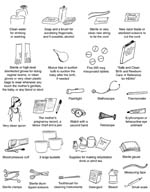3.3.3 Equipment and supplies needed to conduct delivery
You should always have all the supplies and tools you will need for the birth (Box 3.2 and Figure 3.8) ready at the Health Post and you should take them to the woman’s home if the delivery is going to happen there. She may be able to provide some of the simplest things, like soap and clean cloths, but you should always be fully prepared. Use Box 3.2 as a checklist — tick each item as you pack it to go to a birth.
Box 3.2 Checklist of birthing equipment
- Clean water, soap and hand towel.
- Apron, goggle, face mask and gown.
- Sterile gloves.
- Sterile or very clean new string to tie the cord.
- New razor blade or sterilised scissors.
- Two sterile clamp forceps, for clamping the umbilical cord before you cut it.
- Mucus trap or suction bulb to suck mucus from the baby’s airways (if needed).
- Sterile gauze, cotton swab and sanitary pad for the mother.
- Two dry, clean baby towels and two drapes.
- Blood pressure cuff and stethoscope.
- Antiseptic solution for cleaning the mother’s perineum and genital area.
- 10 IU (international units) of the injectable drug called oxytocin, or 600 µg (microgram) tablets of misoprostol. These drugs are used for the prevention of post-partum haemorrhage. Oxytocin is the preferred drug for this purpose, but if you don’t have it then misoprostol can be used. (You will learn all about this in Study Session 6.)
- Tetracycline eye ointment (antibiotic eye ointment used for the prevention of eye infection in the newborn; you will learn about this in the next Module, on Postnatal Care).
- Three buckets or small bowls each with 0.5% chlorine solution, or soap solution and clean water. (To prepare 0.5% chlorine solution you can use the locally available Berekina. Read the concentration from the bottle — if it is 5% you can make a solution of 0.5% strength by mixing one cup of Berekina with nine cups of clean water.)
- Plastic bowl to receive the placenta.
3.3.2 Preparing the birthing place

